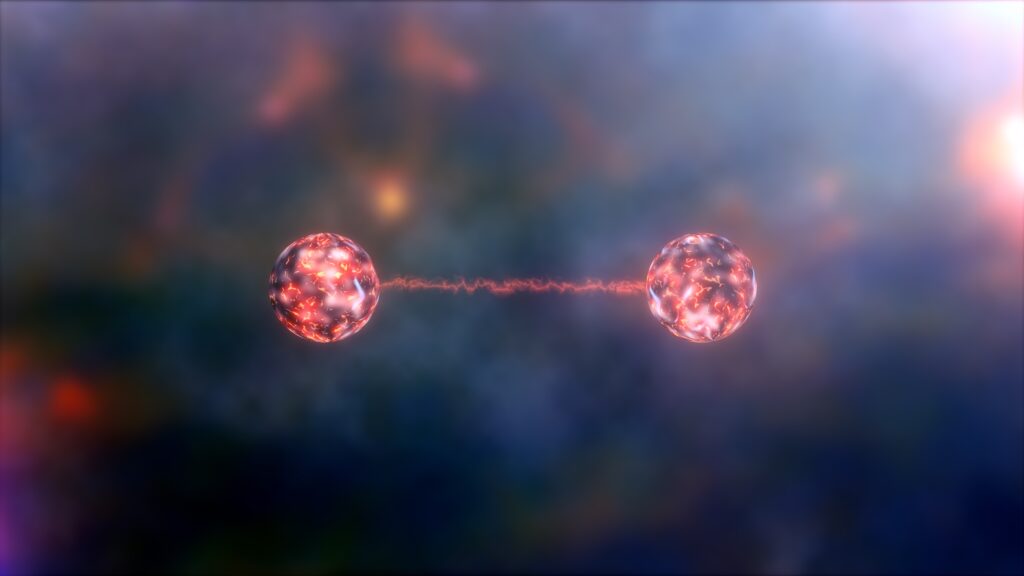Gödel’s Incompleteness and the Realm of Wildlife
Reading | Philosophy
![]() Yaakov Lichter | 2023-12-24
Yaakov Lichter | 2023-12-24

Humans relate to nature through the intermediation of abstract linguistic concepts that aren’t themselves part of nature. Animals, on the other hand, relate to nature through actions—gestures, secretions, sounds, etc.—that evoke meaning in a manner directly grounded in the elements of nature. The potential power of this more direct approach has been illustrated by Kurt Gödel, who used elements of mathematics—natural numbers and arithmetic operations—to model mathematics itself and investigate its nature, thereby unlocking great insight. This is analogous to how animals relate to their world. Could Gödel’s insight help us transcend the artificial boundaries created by our abstract concepts and, thereby, better understand reality?
In the spirit of Newton’s call to build more bridges rather than erect more walls, here an analogy is suggested between the stratagem of Gödel’s proof of his Incompleteness Theorems and the modes of behavior that enable animals in the wild to effectively be one with nature while still spreading their intentions and signaling their status. I suggest that Gödel’s most fundamental intellectual insight—which resides in the world of human thought—parallels what animals possess naturally.
The language in what follows is intended to be accessible to non-mathematicians and provide a preliminary introduction to Gödel’s revolutionary and profound work.
Direct sensations and language
Simone de Beauvoir proclaimed that “humans are the talking animals.” We do not know of any other animal that uses abstract symbols—such as written letters and spoken syllables—as a means of communication, which members of the species have deliberately pre-agreed on. It would be far-fetched for us to think that any other living creature uses abstract words such as mind, consciousness, justice, happiness, sorrow, and so on. In that respect, humans are a unique species. Dr. Doolittle, who allegedly conversed with animals using human concepts, existed only in Hugh Lofting’s fictional books. Being talking and thinking creatures ourselves, when we read Lofting’s books Dr. Dolittle’s talking animals become a sort of reality for us, but a reality in our mind.
Abstract symbols combine in linguistic formulations—such as words, sentences, formulas, etc.—to eventually create for us, humans, stories of various types, ranging from tag lists and simple accounts to legends, narratives, novels, and theories. These abstract symbols—whether written or spoken—do not mean anything to any other living creature.
A human baby is born devoid of language. However, the potential to understand language and use it is inborn in it. Babies start internalizing language the moment they first hear it. This rather cryptic, even mystifying, process is profoundly influential; it creates our framework of thinking. Humans are very self-reflective: they think about themselves, about their experiences and about their very existence. Language causes us to process all of this in a consistent way, thus creating one of the two sources of our knowledge.
Indeed, two essentially different human experiences feed, increase and sustain human knowing. One is our inborn, unmediated, direct natural sensory experiences that are naturally ‘engraved’ in our consciousness, very much like any other animal. This source is not conditioned by knowing any language or the products of language, such as tales, narratives, or theories. The other source emanates from our linguistic experience of becoming acquainted with an ever-increasing number of words, names, statements, etc.
Søren Kierkegaard spoke of the outstanding change that takes place in one’s mind when, for the first time, the fact that everything in their life depends on the way they think invades their consciousness, where they understand that the absoluteness of thought—which stems from the absolute definitiveness of language—takes the place of alleged reality.
Two essentially different realities—one stemming from our direct sensory experiences, and the other from our language-thought experiences—meet and interact in our consciousness in a very complicated, intricate and, in fact, mysteriously entangled way. This interplay yields tremendous human capabilities, with qualities that are unmatched by any other living creature. These unmatched creative capabilities span from profound artistic, literary, and scientific works to horrendous acts of killing and destruction.
One of the most brilliant human achievements of all times is Kurt Gödel’s analyses of the foundations and structure of mathematics as a formal language, as well as its properties. Gödel published his revolutionary work in 1931, thus changing forever not only widespread popular beliefs about mathematics, but also shattering for good what world-leading mathematicians and logicians thought about it.
Gödel’s outstanding logical genius is discussed in a plethora of books, papers, essays, lectures, movies, and video clips. However, perhaps something unique has been overlooked in at least most of them. When comparing Gödel’s most fundamental stratagem—without which the very body of his work would not have been possible—to the way animals get along and ‘communicate’ in nature, an interesting and rather instructive parallel may be drawn.
Metatheories
When Aristotle wrote his teachings about nature—which he called “phusika” (φυσική, in Greek)—he realized that it was impossible for him to explicate nature’s concrete causes and effects, as discerned by the senses, without inventing abstract concepts indicating entities and properties that cannot be directly sensed by us. In order to formulate his philosophical teachings about nature, he had to incorporate these abstractions as an integral part of his text. His disciples decided to gather the definitions and explanations of these abstract terms in a separate section or volume, and then place it right after his physics teaching. The word ‘after’ in Greek is μετά (pronounced ‘meta’), and thus the word ‘metaphysics’ was created. As such, the metaphysics of a certain physical theory is concerned with the investigation, analysis, and description of the theory itself.
This is not exclusive to physics and metaphysics. Each theory can have a metatheory, which investigates, analyzes, and critically describes the concepts, symbols, and inference rules of the theory itself. A particular case of a metatheory is metamathematics.
Understanding that any theory is eventually a story made of language, Rudolf Carnap suggested the following definition for a metatheory: “if we investigate, analyze, and describe a language L1 [and call this study L2] … the sum total of what can be known about L1 and said in L2 may be called the metatheory of L1.”
For a variety of considerations, which are out of the scope of this essay, we will refer to mathematics not as a theory of quantities, but as a theory of abstract symbols free of any interpretation, practical agenda, or empirical experience.
We are now setting out on a journey that takes place solely in the world of human language and thought. Later we will contemplate this abstract world from a standpoint located in the concrete world of direct sensory experiences. Both these worlds constitute the contents of human consciousness.
Formality, consistency and completeness
Historically, the development of mathematical thought has always been accompanied by the emergence of paradoxes. The intensity of this process surged during the 19th century, to the point of becoming a fundamental problem in mathematics and related sciences. David Hilbert, a leader in the community of mathematicians and logicians, called on them to prove that mathematics can be simultaneously a formal, consistent, and complete theory.
The adjectives ‘formal,’ ‘consistent,’ and ‘complete’ are not what mathematics—either as a theory of quantities or a theory of symbols—is about. They are, instead, metamathematical.
What do we mean when we say, ‘formal theory’? The Collins English Dictionary states that it is “a system of uninterpreted symbols and combinations thereof, whose syntax is precisely defined, and on which a relation of deducibility is defined in purely syntactic terms.” That is to say, the truth or validity of one such a theory stems solely from rules and laws related to symbol manipulations, which the theory considers legitimate. A famous example of a formal theory is the basic geometry of the plane, formulated by Euclid thousands of years ago without reference to drawings or plausible experiences. Euclid’s theory is taught in high schools to this day.
It is much simpler and seemingly more intuitive to define ‘consistency’: a theory is consistent when we believe that its text is free of contradictions (it will be understood later why we use the words ‘intuitive,’ ‘believe’ and ‘seem’ in this supposedly simple definition).
The third terms is ‘complete.’ We say that a theory is ‘complete’ if all of its propositions (or formulas) can be proven to be either true or false based on the theory’s axioms and inference rules.
We want to relate the above to mathematical theories. The root of mathematics is arithmetic, so we can widen our field of interest to any theory that includes arithmetic in it. Including arithmetic in a theory simply means that the list of symbols (alphabet) of this theory should include the symbols for the natural numbers (), plus the multiplication, addition, and equality symbols ().
For the sake of brevity, in what follows let the acronym FCAIT denote a Formal, Consistent, Arithmetic-Including Theory.
The fundamental stratagem behind Gödel’s Incompleteness Theorems
In response to Hilbert’s challenge, Bertrand Russell and Alfred North Whitehead published their monumental three-volume book, Principia Mathematica, about the foundations of mathematics. Their book included their new “Theory of Types,” which emanated from their insight that paradoxes exist only in the world of language and thought, their source being self-reference, which language allows. In the context of language, a self-referential statement is one that entails a reference to itself. The ancient symbol of the Ouroboros—a dragon that eats itself—denotes self-reference and illustrates the paradox of something defeating itself.
Russell and Whitehead’s Theory of Types seemed like a complete solution free of self-referential propositions, thus avoiding the paradoxes that arise from them.
When Russell and Whitehead published their book, Kurt Gödel was a child. After having read their book not many years later, he felt—with his extraordinary intellect and mathematical intuition—that it must be impossible to get rid of self-reference in mathematics and, apparently, in any FCAIT.
Gödel’s brilliant intellect led him to a profound stratagem, which enabled the proofs of his revolutionary Incompleteness Theorems. He decided to adopt Plato’s philosophical view that natural numbers should be regarded as a special type of reality in themselves. Though they do not belong to kind of direct sensory experience that we intuitively accept as reality, we should still consider them ‘real’ in our world of language and thought, which ceaselessly interferes with our sensory experiences.
Thus, Gödel devised a code that converts any alphabetical statement or formal proposition into one unique natural number, and vice versa, in a one-to-one mapping. The code he suggested is very simple indeed, and based on the rules of arithmetic. For reasons of brevity, I will not go into its details here (in any case, there are many different methods to create such a code, so the details are less important). The profound point is Gödel’s understanding that such a code is a necessary condition for proving his theorems. It is a necessary condition, but not a sufficient one. He came up with additional ingenious ruses, which are not mentioned here so we can focus our attention on the code only.
By converting formal statements into natural numbers in a bijective way [Editor’s note: i.e., in a way that ensures that each and every formal statement corresponds to one and only one natural number, and vice-versa], it becomes technically, or symbolically, possible for us to replace (a) the verbal concepts and statements with numbers and (b) the inference rules with arithmetic operations. That gets us from the world of regular verbal language, such as English, into the formal language of arithmetic.
This is a change of a medium; will it create a new message? Apparently, it did. It allowed Gödel to prove revolutionary theorems.
Gödel’s Incompleteness Theorems
The first of Gödel’s Incompleteness Theorems claims that FCAITs are necessarily incomplete; i.e., an FCAIT always has statements that can be neither proven nor disproven, which are therefore called ‘undecidables.’ FCAITs necessarily include undecidables.
The second theorem, which is easily proven from the first, says that there is no consistent FCAIT that can prove its own consistency. This is the final fatal blow to Hilbert’s hope—as expressed in the challenge he posed to the global mathematics/logic community—to preserve the image of mathematics as both consistent and complete.
In even simpler language, what we can say with mathematical certainty, based on Gödel Incompleteness Theorems, about the concepts of completeness, consistency, and decidability for any given arbitrary FCAIT is as follows.
Completeness: does every statement that must be true in a theory have a proof in the theory? No.
Consistency: is a theory certainly consistent? Can we be sure that it is free of contradictions? We cannot know the answer to these questions from the theory itself; the property of consistency cannot be proven or refuted within the theory.
Decidability: is there a finite algorithm that can always determine whether a statement follows from the axioms of a theory? No.
Gödel’s realm and wildlife
Gödel’s code is a transformation between two human forms of description, both belonging to the human world of language and thoughts; both using abstract symbols. One form is our regular language, such as these sentences, which we ordinarily use to describe the world and think about it. The other entails the concepts of natural numbers and arithmetical operations.
Animals, as we understand them, do not have a world of conceptual language and abstract symbols. They cannot describe or communicate to other members of their own species, or to other animals, in this fashion.
Originally, I had titled this section “How natural living creatures communicate.” On a second thought, I chose a different title, as you can see above. In my book, Life & Theories: Encounters of the Third Kind, I went even further, referring to animal interactions as messages of nature itself.
The reason I tried to avoid using the word ‘communicate’ is because communication ordinarily implies some form of human-like language—i.e., an ordered combination of abstract symbols like spoken syllables, written letters, mathematical formulas, formal logical statements, etc. Too many people think that we can interpret the way animals conduct themselves as analogous to human language, but animals in nature do not possess such capability. What they do, instead, is to use the objects of nature itself, such as bodily gestures, touches, sounds, tastes, odors, even bodily secretions, which can all be naturally discerned by the senses of living creatures.
For example, we are all familiar with the yawn reflex, which exposes the teeth of the tired animal, thus discouraging any predator that could otherwise take advantage of its fatigue. We see how the fur of a cat bristles and its back becomes curved when a dog attacks it, so the cat looks bigger than it is. Another interesting example is a procession of ants walking along a trail, coordinated by the secretion of various substances (like pheromones). Ants also exercise involuntary physical contact, which excite certain reflexive responses such as opening their mouth to let other ants sense what it carries. They sense the subtle but penetrative sounds of legs strumming the creases on the side of an ant’s stomach. And there are also tastes and smells that ants pass to one another. All these are concrete components of direct sensory reality; all are concrete—none is abstract.
Conclusion
In summary, the means that animals employ to effectively be one with nature, and yet spread their intentions and signal their status, are made of the very entities that nature is made of and do not entail indirection via pre-agreed abstractions. Is the resourcefulness and ability of animals to survive and reproduce in nature, as well as live in sustainable balance with it, a result of their being an integral part of nature?
It is clear that Gödel’s profound stratagem of using solely the very elements of the ‘reality’ of mathematics—natural numbers and arithmetic operations—to relate it to metamathematics itself served as a fundamental key to unlocking the unexpected results of his theorems. A parallel between Gödel’s stratagem and the behavior of animals in nature then seems to emerge: the use of elements of a given reality to relate it to its metareality. This may avoid the barriers caused by a language whose concepts are foreign and irrelevant to the reality it tries to describe. Can it be a clue to deeper insights?
Newton said, “We build too many walls and not enough bridges.” Can the above be the beginning of a bridge that will enable better theories?
This essay reiterates some of the ideas in the author’s book, Life & Theories: Encounters of the Third Kind, 2023.

Essentia Foundation communicates, in an accessible but rigorous manner, the latest results in science and philosophy that point to the mental nature of reality. We are committed to strict, academic-level curation of the material we publish.
Recently published
Reading
Essays
Seeing
Videos
Let us build the future of our culture together
Essentia Foundation is a registered non-profit committed to making its content as accessible as possible. Therefore, we depend on contributions from people like you to continue to do our work. There are many ways to contribute.















